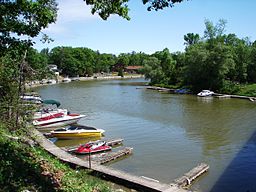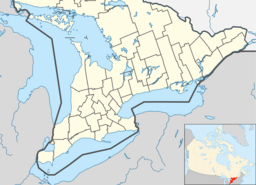Nottawasaga River
| Nottawasaga River | |
| River | |
|
The Nottawasaga River in Wasaga Beach
|
|
| Name origin: From the Algonquin words for "Iroquois" and "river outlet" | |
| Country | Canada |
|---|---|
| Province | Ontario |
| Region | Central Ontario |
| Counties | Simcoe, Dufferin |
| Part of | Great Lakes Basin |
| Tributaries | |
| - left | Boyne River |
| Source | Orangeville Reservoir |
| - location | Orangeville, Dufferin County |
| - elevation | 412 m (1,352 ft) |
| - coordinates | 43°56′29″N 80°05′29″W / 43.94139°N 80.09139°W |
| Mouth | Nottawasaga Bay |
| - location | Wasaga Beach, Simcoe County |
| - elevation | 176 m (577 ft) |
| - coordinates | 44°32′12″N 80°00′29″W / 44.53667°N 80.00806°WCoordinates: 44°32′12″N 80°00′29″W / 44.53667°N 80.00806°W |
| Length | 120 km (75 mi) |
| Basin | 3,361 km2 (1,298 sq mi) |
The Nottawasaga River is a river in Simcoe County and Dufferin County in Central Ontario, Canada. It is part of the Great Lakes Basin, and is a tributary of Lake Huron. The river flows from the Orangeville Reservoir in the town of Orangeville, Dufferin County, through the Niagara Escarpment and the Minesing Wetlands, the latter a wetland of international significance (Ramsar Convention site), and empties into Nottawasaga Bay, an inlet of Georgian Bay on Lake Huron, at the town of Wasaga Beach, Simcoe County.
The river takes its name from the Algonquin words for "Iroquois" and "river outlet".
The Nottawasaga River's headwaters originate in the Niagara Escarpment, Simcoe Uplands, Oak Ridges Moraine and Oro Moraine. The area of the drainage basin is 3,361 square kilometres (1,298 sq mi), and as well as Dufferin County and Simcoe County, is located in Grey County and the Regional Municipality of Peel.
The Nottawasaga River is the resting home of HMS Nancy, a merchant schooner taken into the Royal Navy during the War of 1812. It met three American warships: Niagara, Tigress and Scorpion. The small ship lost the battle but Lt. Miller Worsley and crew escaped. They rowed 360 miles to Fort Michilimackinac and three days later, Worsley returned with 92 men to take the Tigress and Scorpion. Since her sinking, an island formed around the Nancy. The hull is now preserved in a museum at Nancy Island Historic Site which is a part of Wasaga Beach Provincial Park.
...
Wikipedia


